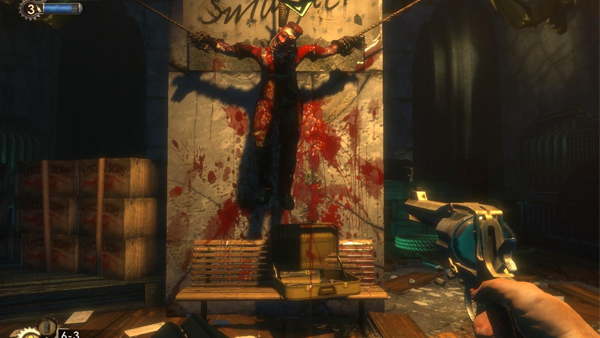Why Bioshock Is Secretly One Of The Best Horror Video Games Ever
There's Always A City

It becomes clear through Bioshock’s story that the lofty heights of objectivist leader Andrew Ryan were too much for Rapture to bear as the city plunged into civil war in the late 1950s. The resulting conflict rendered the city uninhabitable by the mentally stable as the genetically curious inhabitants had been driven insane by their desire to physically enhance themselves, splicing their DNA with Adam, an unknown aquatic entity that quickly became a currency of Rapture.
'Splicers' form the most substantial barrier between Jack and his escape from the city, and while they are somewhat simple to overcome, their aura is utterly terrifying. Their quest for self-betterment has done the exact opposite, rendering them husks of the upstanding men and women they once were. ADAM made quick work of eroding their genetical code, opening the gate for an influx of insanity, meaning each encounter with them is entirely unpredictable. Their addiction to the substance fuelled the rapid descent into madness, and their threatening presence fits seamlessly into the scenery as the inhabitants are decaying as fast as the city they once called home.
‘Big Daddies’ and their companion ‘Little Sisters’ plaster the game’s promotional material, and though encounters with the adversaries make for some of the best gameplay moments, their introduction to the game’s early stages are puzzling. Big Daddies, the colossal entities that our collective minds went wild for, are completely docile. Meandering through the city with their Little Sisters in tow, they only attack when provoked, and though they become a simpler challenge later in the game, early encounters with the mechanical monsters make the player wish such provocation was avoided.

Meandering around the glitzy lights of Fort Frolic or making your way through the once luxurious Olympus Heights is never a simple task, as Rapture's deranged dwellers never far behind. They quickly become a part of the scenery, and knowing that the city's once-promising inhabitants had been subjected to the same decay that their environment had fallen to makes their inclusion in the story all the more viable.
Rapture is the story of what could have been. What was once a pristine place for upper-class toffs to slurp the finest champagne indulge in the most experimental of plasmids (as seen in Bioshock Infinite's superb side story, Burial at Sea) has now fallen victim to the very people who called it home, as the quest for self-betterment came at the cost of sanity.
Poking around the nooks and crannies of Rapture wonderfully feeds the narrative, and though the plentiful audio diaries deliver most of the story, the dingy environments reinforce the twisted tale beautifully. Political propaganda litters the city walls, speaking of revolutionary leaders and libertarian dreams, and though the Ayn Rand influence adds immense depth to the city, it’s how the city’s influence has dwindled over time.
Rapture is not unlike the Arkham Asylum presented in Rocksteady’s first entry to their acclaimed Batman series, with an onslaught of crazies to overcome all while being haunted by what the location should have been. Creeping through its rooms, completely oblivious of what's around each corner is a great source of intrigue, while also maintaining the tension. Wandering through the Medical Pavilion in the game's early stages, noticing the environment plastered with 50's advertisements and mould instead of suitable surgical equipment is a canary in a coal mine for what's to come, but inching through the city's subsequent districts is never repetitive, a feat many survival horror game's fail to achieve.